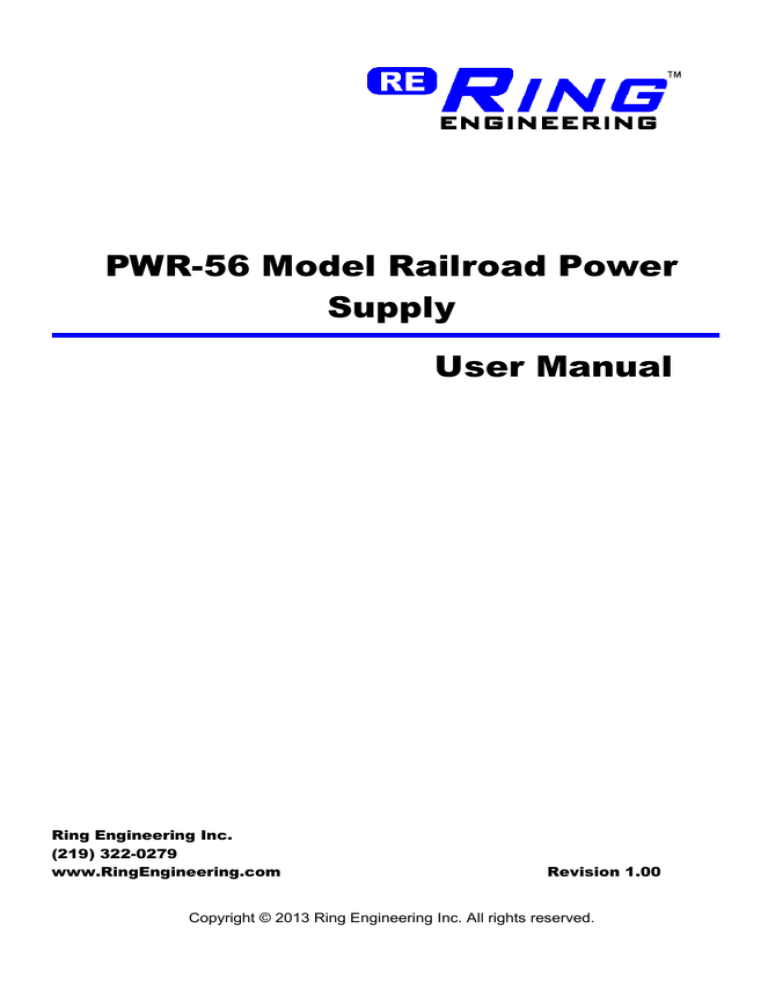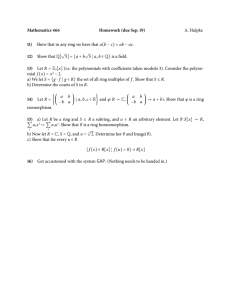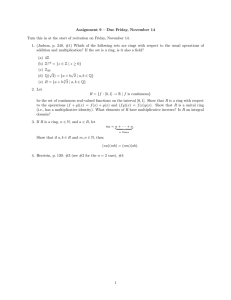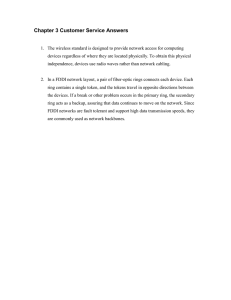
PWR-56 Model Railroad Power
Supply
User Manual
Ring Engineering Inc.
(219) 322-0279
www.RingEngineering.com
Revision 1.00
Copyright © 2013 Ring Engineering Inc. All rights reserved.
Introduction
Thank you for purchasing this Ring Engineering product. We take pride in the products
that we produce and hope you find this product to be a great addition to your model
railroad layout.
Please read all warnings and instructions before installation and use. For the latest
information including the latest revision of this manual please visit our Internet site at
www.RingEngineering.com.
The PWR-56 is a Power Supply that can be used to supply power for your locomotives,
turnouts and other accessories. The PWR-56 has 56 watts of output power! That is
enough power to drive 15 or more typical modern locomotives! Also, the advanced
technology of the PWR-56 maintains a stable output voltage within about 3% from no
load to full load! Typical model railroad power supplies can have voltage drops as high
as 30% at full load. Unlike typical model railroad power supplies, when you need full
power, your Ring Engineering PWR-56 will deliver! Further, each PWR-56 is equipped
with Direct Radio! Because it has Direct Radio you can control, setup, and monitor your
PWR-56 with any RailPro controller, such as the HC-2 with color touch screen, without
connecting any wires. With a RailPro controlling device, you can turn the output to the
track on or off, monitor the output power your PWR-56 is delivering, adjust settings, and
more!
Introduction___________________________________________ 2
Warnings _____________________________________________ 3
RailPro _______________________________________________ 4
Features______________________________________________ 5
Installation____________________________________________ 5
Password____________________________________________ 10
Multiple Power Supplies________________________________ 10
Troubleshooting ______________________________________ 11
Warranty ____________________________________________ 12
FCC Statement _______________________________________ 12
Ring Engineering Inc
2
Warnings
•
•
•
•
•
•
•
This product is not recommended for persons under the age of fourteen (14).
No user serviceable parts inside. Return to Ring Engineering for repair.
Do not connect any products to the PWR-56 output unless it has a Ring
Engineering controller module installed. For example: a locomotive should not be
placed on a track that the PWR-56 is connected to, unless it has a Ring
Engineering LM-x module installed into it.
Never connect this Power Supply to a track that is connected to another
manufactures power supply. Damage could happen to either power supply and in
the worst case may result in a fire.
Always follow the directions that Ring Engineering provides if you are going to
connect multiple Ring Engineering power supplies to the same model railroad
layout.
Be sure that your layout passes the short circuit test described in this manual
before you operate your model railroad layout.
This product contains a chemical known to the state of California to cause cancer
and birth defects (or other reproductive harm). This product contains lead.
Ring Engineering Inc
3
RailPro
Your PWR-56 is a RailPro product by Ring Engineering!
TM
RailPro
DIRECT
TM
RADIO
RailPro products by Ring Engineering are professional and very easy to use model
railroad control products, which can be enjoyed by beginners and experts alike.
RailPro products are equipped with Direct Radio and are designed to work together to
make a control system for model railroads. Direct Radio allows the RailPro components
to communicate with each other without any wires! Direct Radio is very fast giving your
RailPro products quick response to your controls. A typical RailPro system would
consist of a Controlling device, like the HC-2, a power supply, locomotive and other
accessory modules. The HC-2’s color touch screen displays the products for you to
control. By simply touching the screen on a controlling device you can control, setup
and monitor your locomotives, accessories modules and this PWR-56. You can add
additional controlling devices, locomotives, and accessories to take full control of your
model railroad layout! RailPro makes adding new products like this PWR-56 easy. All
you have to do is press the “Find Product” button on the touch screen. RailPro will
search for the new products and load the new products image onto the controller. Next,
all you need to do is touch the picture of the product you want to control and you are in
control! The color graphic screens make it so simple to use that many users will not
need to read the manual to even setup advance features because all the controls are
displayed with pictures and meaningful text.
Ring Engineering Inc
4
Features
•
•
•
•
•
•
•
•
•
•
Simple setup via a Color Touch Screen Controller. The setup using a RailPro
controller is so easy many users may find it not necessary to use a manual.
You can give the PWR-56 a Password so only the people you want can control
the PWR-56.
You can give the PWR-56 a name so it can be easily recognized on the
screen.
Short Circuit detection with auto recovery.
Can be used as a Direct Radio Repeater.
Monitor the output power with a RailPro controller.
Monitor the temperature with a RailPro controller.
The PWR-56 has regulated output. When your locomotives need more power,
the PWR-56 delivers!
You can use multiple PWR-56’s to increase the number of locomotives and
other accessories.
The PWR-56 program can be updated to a newer revision by receiving
information through Direct Radio! It is possible that you will be able to get a
newer version of the program for your PWR-56 from Ring Engineering’s
Internet site and add new capabilities that currently do not exist in your PWR56! There are two ways to update the program in this PWR-56. 1) Use a
controlling device like the HC-2 and load a new program from Ring
Engineering’s Internet site www.RingEngineering.com. 2) Send the PWR-56
back to Ring Engineering and our technician can do it for you. There will be a
fee involved to send the PWR-56 to Ring Engineering for an update.
Installation
Step 1
Choose a good location for your PWR-56.
The best location for the PWR-56 is near the middle of the track. There are two reasons
for locating the PWR-56 near the middle. The shorter the wires are to the track, the less
power will be lost in the wiring. The second reason is your PWR-56 makes a great
Direct Radio repeater. Your controlling devices can send commands directly to your
products, such as locomotives, or your controlling device can send a command to your
PWR-56 first and your PWR-56 can send the command on to your locomotive. By using
repeaters, your RailPro system can have multiple paths for communication providing
dependable communications to your locomotives, accessories, etc. Please see your
controlling devices manual for more information about Direct Radio repeaters. If you
have more than one PWR-56, it is best to equally space the PWR-56’s and centrally
locate them like in the figure below. It is recommended to space multiple PWR-56’s 15
ft apart or less for the purpose of Direct Radio repeaters. It is very possible that much
greater spacing will work well. With 4 repeaters, the effective control area is over 2000
sq ft (45 ft x 45ft).
Ring Engineering Inc
5
Step 2
Connect the two Output terminals to your track.
For a simple and small track, all you need to do is connect two wires from the red and
black terminals on the PWR-56 to the track. Each of the two output terminals needs to
be connected to one rail of the track. If you only have one power supply, it does not
matter if the red or the black terminal is connected to a particular track rail. If more than
one RailPro power supply will be used together, read the section “Multiple Power
Supplies.”
For larger layouts, you will need to run bus wires under the track in order to have good
power distribution throughout your entire layout. Basically, you should have two heavy
gauge wires (Bus wires) under the track and periodically have much smaller wires
(Feeder wires) that connect the bus wires to the track rails. The bus wires should be
16AWG. The feeder wires can be 22-24AWG. Feeders should be connected about
every 6 - 10 feet. For 16 AWG the bus wire length should be limited to 30 feet or less.
Contact Ring Engineering for wiring layouts that need more than 30 foot runs with a
single power supply. The power wiring for a good analog or DCC system should be
good for a RailPro system. If your layout passes the coin test described below, then
your wiring should be adequate.
Ring Engineering Inc
6
TIP: You may get away with fewer feeders than one every 6 - 10 feet particularly if your
individual sections of track are soldered together. Your wiring is good enough if you can
pass the coin test described below.
The PWR-56 is equipped with spring-loaded terminals for fast and secure connections
that do not require a tool. To connect a wire to the terminals, first strip 3/8 of an inch
(about 2/3 the length of the terminal block) of insulation off of the wire. Then press the
orange push button over the contact that you want to connect a wire to. Insert the wire
into the round hole under the orange push button. Be sure the wire goes all the way to
the back of the terminal block while holding down on the orange push button. When you
feel the wire touch the back of the terminal block, release the orange button to secure
the wire into the terminal block. Give the wire a tug to be sure it is securely connected.
Wire Gauge
Maximum #16
Position the PWR-56 under your layout. Use at least 2 screws and mount the PWR-56.
If only using two screws, be sure the screws are located in opposite corners. The red
arrows in the figure below identify mounting hole locations.
The only acceptable mounting orientations are: 1) Mounted to the bottom surface
of the layout with the RailPro logo facing the ground or 2) Set on top to the layout with
the RailPro logo facing the roof. Also there should be at least 2 inches of space on
each side for air circulation.
Step 3
Plug the power cord of the PWR-56 into a standard wall socket.
Your PWR-56 light should be green indicating that the output is on. If the light is red or
not lit up, please check the troubleshooting section. The PWR-56 outputs power to the
track as soon as the power plug is plugged in. It is recommended that you plug the
Ring Engineering Inc
7
PWR-56 into a power strip with an on/off switch so you can easily turn the PWR-56 on
and off.
Step 4
Do the Coin Test before using your PWR-56.
This step is important. This step is important because your PWR-56 needs to be able
to shut off when the track is shorted. This test will confirm if your track is wired well
enough so the PWR-56 will be able to detect the short and turn off. If the track is
shorted and the connection of the PWR-56 to the track is poor, the short will not draw
enough power from the PWR-56 to detect the short, and the PWR-56 will not turn off,
delivering power to the tracks bad connection. Although it is very unlikely, it is
conceivable that a bad connection could heat up enough to ignite flammable material
near the bad connection. This precaution would be the same for any model railroad
power supply with the same amount of power whether it was RailPro, DCC, or Analog.
Use a quarter and place it across the rails of your track as shown in the figure below
and be sure the PWR-56 power indicator light turns red. A red light indicates that the
short was detected and the power to the track was turned off. If the light does not turn
red when the quarter is positioned on the track, then the wiring to that section of track
needs to be improved. You may need to improve the connections to that section of
track, or use thicker gauge wire to feed that section of track. Go along the track and do
the quarter test to every section (at least every 3 feet) of track until each section is
tested and passes this test.
Coin Test
Since the track is exposed and can easily be shorted by things like a derailed
locomotive, your PWR-56 has built in short circuit protection with auto recovery. When
a metal object gets across the track rails, the PWR-56 red terminal is connected to the
PWR-56 black terminal and you create a short circuit. The PWR-56 will automatically
detect the short circuit, turn off the output, and the power indicator light will turn red. If
the output is off, all trains will stop because they will no longer have power. The power
indicator light will stay red until the short is removed. After a few seconds from the short
being removed, the PWR-56 will automatically turn the power to the track back on, and
the power indicator light will turn green.
Ring Engineering Inc
8
Step 5
Detect your PWR-56 with each Controlling Device.
Before you will be able to control or monitor your PWR-56 you will need to detect it with
a controlling device such as the RailPro HC-2 handheld controller with color touch
screen. On your controller, you will need to press the “Find Product” button. Your
controller will display “Loading Product”. After that, you will be able to select this PWR56 from your Accessories page. After you have detected the PWR-56, you will be able
to turn the track output on or off. You can also monitor the total power that your PWR56 is delivering. If the power you are using is near 100% then you should buy another
RailPro power supply to add to your system. You can even see if the temperature of the
PWR-56 is OK.
It is important that each controlling device that you will use in your system detects each
RailPro power supply in your system. Each controlling device has a Stop All - Power
Off option. The controlling device will only send a “turn off the power” command to the
PWR-56 that it has detected and loaded. Please see your controlling devices manual,
such as the HC-2’s manual for more information.
Step 6
Give the PWR-56 a name and a Password.
This step is optional.
The reason to give your PWR-56 a name is so you can tell it apart from another PWR56. If you had two or more PWR-56s and did not name them, it would be difficult to tell
which one you are going to control when you touch the picture of a PWR-56 on your
controlling device. For example, if you have two PWR-56’s, one located more towards
the north on your layout and one located more towards the south, you may name one
“North” and the other one “South.” Then when you select the PWR-56 named “North”
you could be confident which one you would be adjusting and controlling. You can give
the PWR-56 any name that you would like.
It is recommended that you give your PWR-56 a password. Please read the Password
section for more information.
Step 7
Your PWR-56 is Ready to Use.
Ring Engineering Inc
9
Password
You can set a password in your PWR-56. Further, it is recommended that you set a
password in your PWR-56 right after you receive it. When shipped from the factory,
your PWR-56’s password is blank. When the password is blank, any RailPro controlling
device can detect and control your PWR-56. Since RailPro uses direct Radio, it is
possible to detect and control your PWR-56 from over 100 ft away. In other words, it is
possible for your neighbor to control your PWR-56. However, if you put a password into
your PWR-56, then your neighbor will not be able to detect and therefore not be able to
control your PWR-56.
If you are going to use your PWR-56 in a train club, then you may want to give each
RailPro power supply the same password. Therefore, when a club member gets a new
controller, they can detect each power supply so their controller can send a “Stop All Power Off” command and cause this power supply to turn off its output. See your
controlling devices manual for more information on this feature.
Multiple Power Supplies
A single PWR-56 is likely to operate 15 or more modern HO scale locomotives at the
same time. However, if you want to run even more locomotives, turnouts, lights, etc,
you can by adding multiple PWR-56’s to increase the available power to your model
railroad layout. You can add a second, third or even more power supplies by wiring
them to your track as shown in the figure below. You will need to be sure the red
terminals are connected to the same rail and black terminals are connected to the other
rail. You will also need to be sure the red terminals of the power supplies are isolated
from each other by placing gaps in the rail that the red terminals are connected to.
Connecting Multiple Power Supplies
TIP: It is recommended that the PWR 56’s wiring be connected to the track farther from
the insulated gap instead of near the insulated gap. The farther from the insulated gap
that the PWR-56’s are connected to the track, the better the PWR-56’s will share load
when an insulated gap is crossed by a locomotive.
Ring Engineering Inc
10
Troubleshooting
Problem
The power indicator light does not
come on when the power switch is
turned on.
Solution
Be sure the power cord is plugged into
the wall.
Be sure the wall outlet has power.
The power indicator light is yellow
and there is no power to the track.
The PWR-56 is on but not outputting
power. Use a controlling device such
as the HC-2 and turn on the output.
The power indicator light is red.
The output is shorted. Remove the
short. If you remove the wire from the
red or black terminal and the light turns
yellow then your short is in the wiring
to the track.
Check the information page on a
controlling device for this power
supply. If the information page
displays “Over Temperature” then be
sure there is at least two inches of
space all around the PWR-56.
There is no power to the track the
light is green.
If the light is green, connect a wire
directly across the Red and Black
terminals. If the light turns red (there
must be power on the terminals) the
problem is the wiring from the
terminals to your track.
Ring Engineering Inc
11
Warranty
Limited One Year Warranty
Ring Engineering, Inc. (Ring Engineering) warrants that for a period of one year from the date of purchase, this
product will be free from defects in material and workmanship. Ring Engineering, at its option, will repair or
replace this product or any component of the product found to be defective during the warranty period.
Replacement will be made with new or remanufactured product or component. If the product is no longer
available, replacement may be made with a similar product of equal or greater value. This is your exclusive
warranty.
This warranty is valid for the original retail purchaser from the date of initial retail purchase and is not
transferable. Ring Engineering dealers, distributors, or retail stores selling Ring Engineering products do not
have the right to alter, modify, or any way change the terms and conditions of this warranty.
The warranty does not cover normal wear of parts or damage resulting from negligent misuse of the product.
Further, the warranty does not cover Acts of God, such as fire, flood, hurricanes, and tornadoes.
Ring Engineering shall not be liable for any incidental or consequential damages caused by the breach of any
express or implied warranty or condition. Except to the extent prohibited by applicable law, any implied warranty
of merchantability or fitness for a particular purpose is limited in duration to the duration of the above warranty.
Ring Engineering disclaims all other warranties or conditions, express or implied statutory or otherwise. Some
states or jurisdictions do not allow the exclusion or limitation of incidental or consequential damages or limitation
on how long an implied warranty lasts, so the above limitation or exclusion may not apply to you. This warranty
gives you specific legal rights, and you may also have other rights that vary from state to state.
To obtain warranty service contact Ring Engineering at:
Email: info@ringengineering.com
or Phone (219) 322-0279
to get a return authorization and return instructions.
If your Ring Engineering product is not covered by warranty, or has been damaged, an estimate of repair costs or
replacement costs will be provided to you for approval prior to servicing or replacement.
FCC Statement
This equipment has been tested and found to comply with the limits for a Class B digital device, pursuant to part
15 of the FCC Rules. These limits are designed to provide reasonable protection against harmful interference in a
residential installation. This equipment generates uses and can radiate radio frequency energy and, if not
installed and used in accordance with the instructions, may cause harmful interference to radio communications.
However, there is no guarantee that interference will not occur in a particular installation. If this equipment does
cause harmful interference to radio or television reception, which can be determined by turning the equipment off
and on, the user is encouraged to try to correct the interference by one or more of the following measures:
• Reorient or relocate the receiving antenna.
• Increase the separation between the equipment and receiver.
• Connect the equipment into an outlet on a circuit different from that to which the receiver is connected.
• Consult the dealer or an experienced radio/TV technician for help.
Ring Engineering Inc
12







